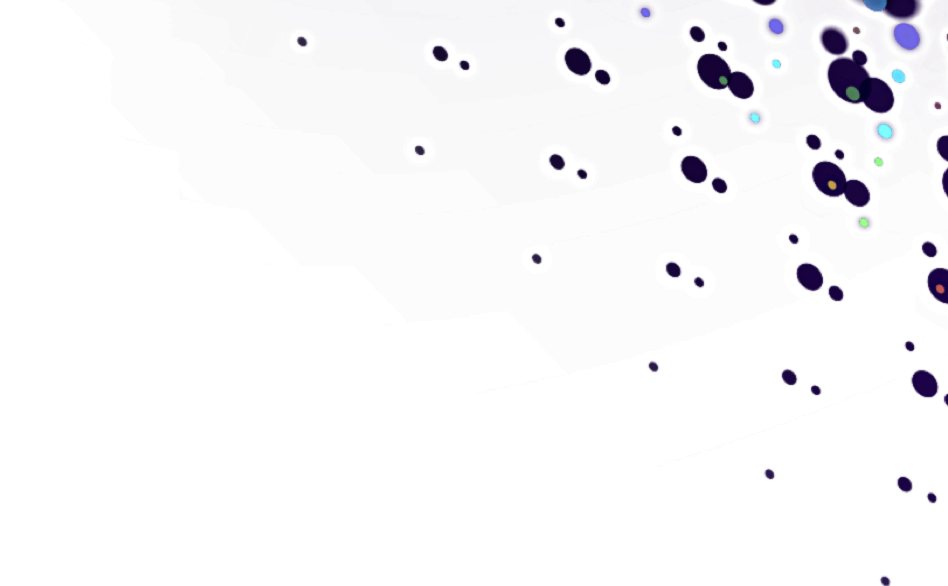Basic Facts about CA method
CA method is a diagnostic tool comprised of a palette of eight colours, and calibrated sets of words, images, and videos. These elements can be edited to answer specific questions or issues. Data collected by the Method is automatically evaluated online in the computing core. Diagnostics outputs consist of particular results in numeric form, which are represented by output reports. Alternatively, when artifical intelligence is integrated into a product, the diagnostic results will affect the behaviour of the application.

Diagnostics
Description of Colour Association Method (CA method)
CA method is a combined projective technique, that uses calibrated sets of words or visual objects (30-150 words or visual objects), and a palette of eight colours. The eight different colours differ from each other by measurable wavelengths. These colours form the basis of the so-called Small Lüscher Color Test - see link. Numerical coding of each colour (in accordance with the Lüscher Color Test) remains the same, making it efficient for the computer to record people’s specific reactions (answers) to a given stimulus word or visual object. For each stimulus word or visual object presented to a respondent, they must choose three of the eight colours. Respondents are forced to rank the colours, as it is not possible to choose one colour multiple times. This means that there are 336 possible reactions (tri-colour combinations) for every particular word and visual object.
It is possible to use this tool to assess human reactions because of two association areas in the brain called Broc’s Motor Center and Wernicke’s Sensory Speech Center (see link). The innovation of colour test and colour association allows us to focus on different areas of human behaviour and experience. CA method combines the benefits of both the colour test and colour assocation. At the same time, it uses an interdisciplinary approach, respeciting the empirical findings of many scientific fields of study, e.g. psychology, biology, physics, sociology, neuroscience, and social psychology, among others.
CA method measures the social-psychology attitude spectrum, including not only what people think and what they prefer, but also whether they will project their attitudes in their behaviour, how successful they will be, and in what timeline. It also measures the dynamics of functional processes of consciousness, attitudes, and consequently complex units within the consciousness (of an individual or a group). Diagnostics (data collection) is performed through a computer program.
Diagnostics and Means of Data Collection
The latest version of the diagnostics is always used for data collection. The most recent version has been changed and customised from the original version with regards to the combined colour association assigning and choosing in order to create a "diagnostics mask" to eliminate the perceptual defense as much as possible. Where possible, it also avoids inducing spatial perceptional stereotypes by imitating natural empirics rather than human creations in its shape and colour “area”.
The content of changes made in the diagnostics mask:
Non-homogeneous Colour Area
There are two reasons for choosing these parameters. First, if we rule out man-made creations in the empiric reality of the outside world (the Not-Me Principle), no homogenous colour areas occur. Therefore, the human brain was not functionally formedin a homogeneous...
Read moreThere are two reasons for choosing these parameters. First, if we rule out man-made creations in the empiric reality of the outside world (the Not-Me Principle), no homogenous colour areas occur. Therefore, the human brain was not functionally formedin a homogeneous environment. The man-made world is expressed in homogeneous colour schemes. These colour schemes affect humans in ways we already consider inherent, though from an evolutionary standpoint it is insignificant and negligible. It is possible that this may not continue into the future, but that is dependent upon whether or not humans will realise that all production, yields and pursuit of “absolute perfection” could turn into dead-end street leading humanity to its own extinction.
Secondly, even if we strive to create a spectrally homogenous colour, it is impossible to achieve as the wavelength varies depending on how it interacts with the environment. Aside from that, new brain research has shown that colour perception is based on a special distributed neural network that is constantly decoding and guarding two brain evaluation processes. Therefore, it doesn’t matter what our eye sees, the eye is merely an entry gate for these processes. The evaluation processes involve the stability of the colour spectrum and individual colours (the wavelength of certain colour), and the size of the deviation in the wavelength within the brain's own records about the colours in the outside world. Using this knowledge, we can understand and explain the phenomenom of seeing colour in very dim light, even though our eyes cannot perceive it. For example, we can still tell that leaves are green in light that is too dim to see that they are green. That's because the the brain makes the leaves ready to be green. The leaves will continue to be perceived as green unless their internatl structure changes and they interact differently with the available light.
As CA method is striving to use the associative connection between colours and either verbal or visual objects, it is more convenient to use the widest possible wavelength for each colour to stimulate these associative connections. Just as focusing on the widest possible wavelength will assist in making better associative connections, CA method also focuses on using common language symbols for communication that are held lexically in the long-term memory for a more accurate reply from respondents. Humans are a diverse species, so you can imagine how difficult it would be to ensure that every individual learns and stores information in the exact same way. In fact, it would be an impossible task. It has been shown that no brain works identically to another. This is understandable considering the in its variability, mutability, action time intervals, frequency, etc, inherent in the outside world. This means that the verbal or visual object can be used for a scale of common lexical meanings.
Read lessObject inside the Circle
From the spatial point of view there is the endeavor to change the reaction object into an imaginary perceptional center (a dominant) from which there would be a substantially more similar...
Read moreFrom the spatial point of view there is the endeavor to change the reaction object into an imaginary perceptional center (a dominant) from which there would be a substantially more similar distance to individual colours than it is in the case of former imaging way.
If we think about the direction of the process at the beginning of individual word and visual object and the colour connection in the brain, we can tell it is mostly about gradient centered storing of records from many details (colours) into one common center. Given the fact that both the technique and method have projective characteristics, and are trying to map, while respecting distinctive differences within an individual, what this individual uses for interaction and communication with the world. (the model of Object-Communication Consciousness is drafted as such), the projection process will run into the exact opposite direction. That means from the center (word or visual object) variably into the surroundings (colour).
Both colour scheme selections (initial and final) are draw up in the spirit of this view. The initial one is closer to the conception of the way how and why we are interacting with the outside world. The final one corresponds more with the conception of how and why we are responding to those interactions since it is compiled right after the stimulation by all objects of the chosen module. While maintaining this spatial consistency for both selections and own colour associations to the objects we could presuppose that the outputs transcribe both the process of what we are “learning” from and the process of what we project (produce and use) from the learned content.
Read lessCircular Formation of the Eight Colourful Balls
This change was made in order to avoid the learned perceptual kinetic eye-moving stereotype that is created while reading and writing. It cannot be used in this...
Read moreThis change was made in order to avoid the learned perceptual kinetic eye-moving stereotype that is created while reading and writing. It cannot be used in this way in any of the culturally demographic environments of Europe, America, Asia, Africa, etc., that is, by font type (character, picture) neither by general practice of top left – right down, not even by the opposite one such as is used e.g. in Hebrew. This arrangement would only imitate the stereotype of displaying time on a clock, i.e. a gradual rotation to the right. Nevertheless, the rotation to the right is a universal and almost 100% present “natural movement” of the material world (see Richard P. Feynman: The Character of Physical Law, BBC 1965). We assume, therefore, that it should not create an unnatural perceptual movement that would initiate a number of defense mechanisms.
Moreover, the closed circle does not have its own perceptual “stable spatial beginning”. Instead, the “spatial beginning” is determined by the client's first choice. It is therefore appropriate to set up an internal control mechanism for recording the preferential colour scale selection (the initial and final colour selection), which psychometrically monitors the prevalence of preferential colour scales by a continuous “gradual hourly stereotype”.
The shape of the circle remains visible even after a colour has been chosen, and the ball has disappeared. This initially perceived shape, at least in part, prevents the perceived formation of shapes not enclosed in the working memory.
The arrangement of the balls in the circle is manipulated so as to not continuously copy the most common or most frequently prefered colour order in the population. Similarly, there are no side-by-side colours that show a statistically strong increased incidence when selecting tri-colour combinations for verbal stimuli (the colour trio Red, Yellow, Purple; and the colour trio Brown, Gray, Black). Thus, the principle of “ease and spatial movement relief” is not supported either in the decision-making phase of the choice or in the movement phase when the selection is made with the mouse or finger on the touch screen.
During the diagnostics process, the whole circle of colours is rotated 90 degrees to the right after the first quarter of stimulus words have been used. The circle is rotated in order to stop the emerging spatially permanent recording of the arrangement of the coloured balls by the client's working memory.
Read lessThe Shape of “Simulated” Balls
The original squares were changed to circles, or balls, because scientific disciplines such as astronomy, physics, chemistry, and biology, demonstrate that it is a distinctly natural shape that can be...
Read moreThe original squares were changed to circles, or balls, because scientific disciplines such as astronomy, physics, chemistry, and biology, demonstrate that it is a distinctly natural shape that can be perceived where diverse dynamic movements, changes, and interactions occur. That is, a variety of “inaccurate balls”. The balls are not two-dimensional surfaces, but three-dimensional bodies. From the ponit of view of evolutionary developmental principles for time, energy and space, we can assume that CA method and the OCAC method should also respect this rule if they are to stimulate and map the psychic processes connected to the neurological systems, and that the circular or ball shape should evoke few perceptual defenses.
The ball is used extensively throughout sports and entertainment games in which movement and space are a primary part of the game environment. Games as a principle of human activity are often emotionally positively accepted and used throughout life. Games provide activities in which the conscious and controlled rational processes do not prevail, but there is a holistic, integrated immersion or pull into the game. The intrinsic nature of the stimulation material for the colour association, as well as the instructions for diagnostics, should evoke and utilize these specifics as far as possible. The described aspect is then offered on the home screen. People who have tried the CA method diagnostics describe more the aspect of the game (regardless of their age), instead of feeling stressed while being tested, which respondents sometimes feel when completing classic tests.
Read lessSpatial Perseverance
In the circle of eight balls, within which each ball has its own distinct colour, the three most frequently chosen colours ('trios') never occur side by side, thus eliminating the spatial perserverence.
Diagnostics process (data collection)

The diagnostics has three stages and the respondent follows a set procedure:
Initial Colour Choice
Look at the colours, let them interact for a while, then select all eight colours in order from the most pleasant to the least pleasant.
Words and Visual Objects Associations
Look at the colours and let them interact for a while, read the word out loud, look at the picture or short video, look at the colours and select three of them as quickly as possible
Final Colour Selection
Look at the colours and let them interact for a while, then select all eight colours in the order which they affect you at the moment. This is not a memory test, the order the colours are selected in can be completely different, similar, or the same, as the order that you selected them in at the beginning of the diagnostics.
Diagnostics can be performed individually or in groups. The whole process takes from 3 to 30 minutes depending on personal pace, and the number of words or visual objects to which the respondent responds.
Editing the research area and calibrated sets
of words and visual objects
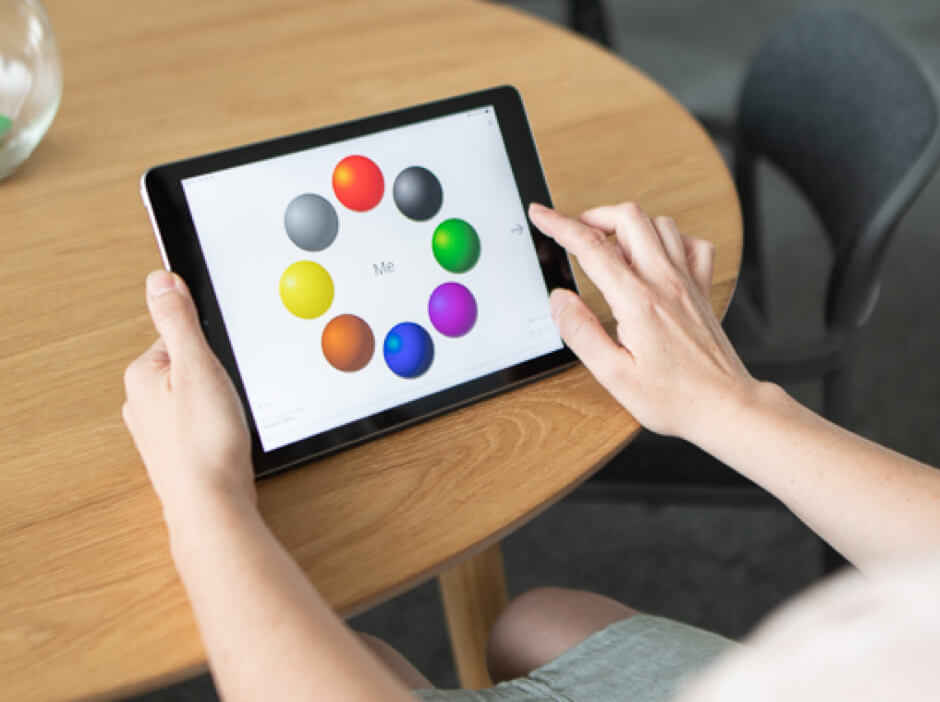
A calibrated set of words and visual objects consists of a group of verbal objects and visual objects that themselves describe the area of interest. CA method uses sets of words and visual objects that are balanced and tested on hundreds of thousands of clients. Databases of verbal and visual objects can be modified according to the focus of a particular problem or area of interest.
Visual objects such as images or short videos are used in marketing products based on CA method. The Method was used for marketing purposes for the first time in 2013.
Calibrated word sets for each research area are compiled on the basis of semantic analysis. The validity and accuracy of the selected verbal objects is verified on a suitably selected test group. A representative sample of respondents (individuals or groups) is selected based on age, gender, diversity, and specificity of the environment, type of school, etc., so that the selection corresponds to the objective of the monitored (measured) area.
Subsequently, the relationships (correlations) between individual verbal objects and the measured feature (the monitored area) are measured. Also the distinctive ability of individual verbal objects is investigated. Verbal objects, which have been validated for measuring a particular feature, are then grouped into separate word groups called factors. This procedure is then repeated for each subunit, or feature, of the area under investigation. After analyzing all word groups and verifying them with the test group of respondents, the only words and their word groups that remain are ones proves to have the ability to differentiate. This creates a calibrated word module for the area of inquiry.
At the same time, the norms of the word groups (factors) are calculated. For each word group, the rate of how the test respondents usually perceive the verbal object is set. The measurement result is an indication the meaning and the value of the word group (verbal object) carries for each respondent individually. And how much it correlates or differs from the average perception of the word. The recorded value and meaning of the word groups then go through analysis and evaluation using the Object-Communication Analysis of Consciousness. The result of the diagnostics is graphically represented.
Online Computing Core
Object-Communication Analysis
of Consciousness (OCAC) Method
OCAC is a method through which the recorded association processes of individual semantic objects are processed and recorded. The system converts analytical data into a structured consciousness map (hierarchy of attitudes and values). An online computing core operated in a cloud based server has been created for the analytical evaluation and application utilization. The evaluation examines colour preference in first and second selection, frequency of individual colours selected, and selections of colour pairs and colour trios. The system allows the correlated data to be filtered, compared, simulated, re-structured, while not losing or distorting the information about the complex structure and strength of the binding correlations of each consciousness. Based on this data, a presentation layer is created where data is visualized.
The OCAC method both allows cross-sectional measurements (i.e. state) and evaluates developmental trends (prognosis) of individual attitudes (mental processes) in the time horizon of 6-12 months, for summed attitudes (for whole semantically defined topics) up to 3 years, including monitoring the effectiveness and dynamics of change. If any intervention has been used in an individual or group, re-diagnosis is of great value.
For didactic purposes and study material, the author created a colour graphic model that illustrates the scheme of integrated consciousness and depicts the functional processes of OCAC. It is possible to monitor the passage and behaviour of information (stimulus) in the consciousness system based on the interaction of the four autonomous subsystems of consciousness (physical, emotional, intellectual and relational systems) with the environment.
Scheme OCAC
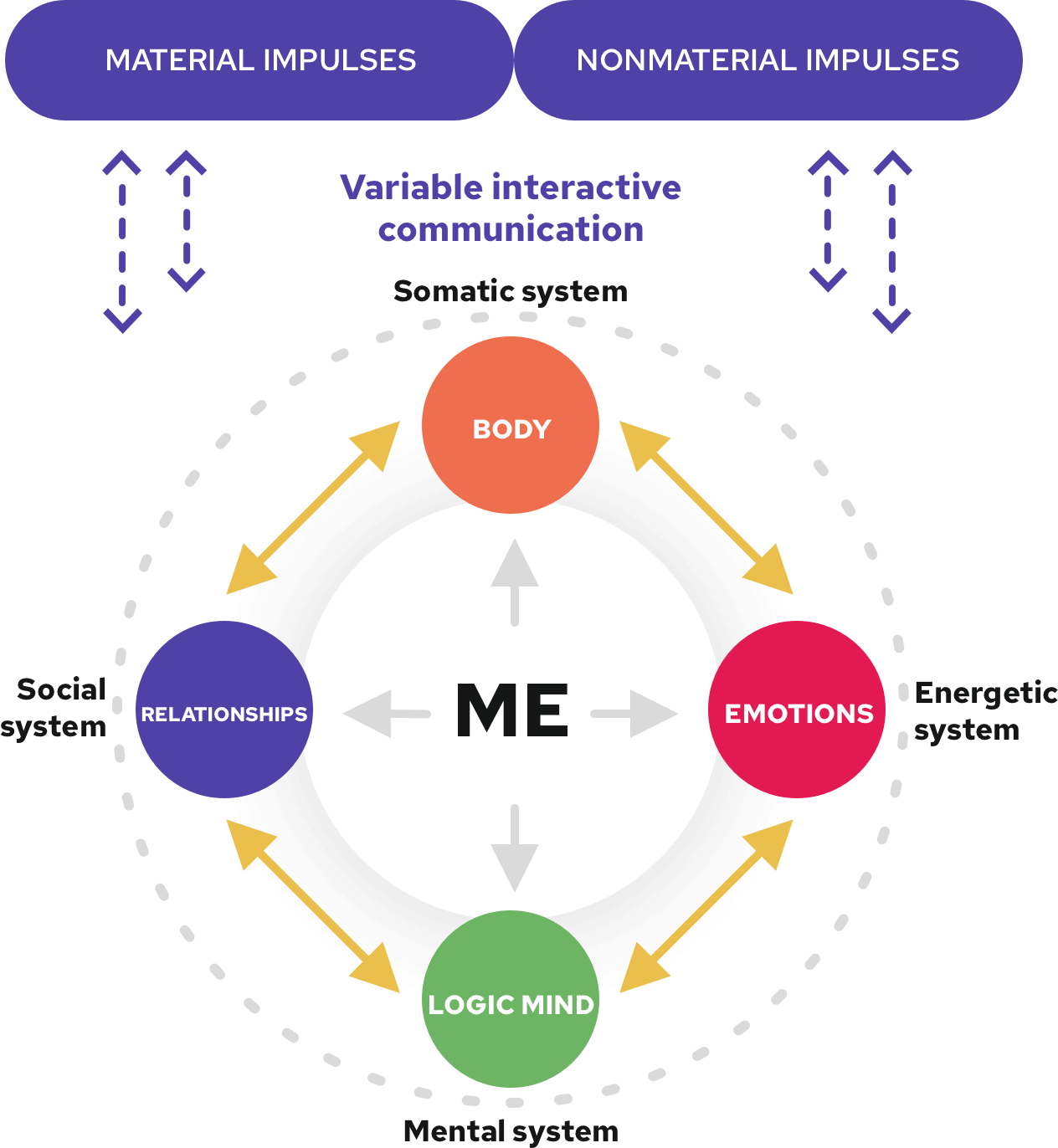
All systems function essentially as one unit (the integrity of consciousness) and form a specific, individually internal and integrated consciousness of the individual. Each individual system produces and processes its specific information and sends it back to the communication circulation of consciousness in its specific communication form: somatic - energy - mental - social. Ontogenetically and phylogenetically, the development always proceeds to the right (right-hand helix) and starts from the Body, i.e. the sequence Body - Emotions - Reason - Relationships.
Therefore, primary processing at the body level takes place first. The body (the somatic system) has all external and internal sensory organs available for stimulus input and identification. Then there is the basic functional system – nervous system with the participation of all others (lymphatic, blood, muscle ...) responsible for their transmission and administration. The association processes that are “technically” taking place throughout the nervous system make up the common and integrated transmission medium through which all four systems are able to grasp, process and participate.
There is a fully registered information flow in the brain, creating an integrated complex of consciousness with the participation of all four systems. So-called dynamic association stereotypes (attitudes), which the integrated consciousness uses, are specifically created and used for the effective functioning of the integrated consciousness of the individual. As an individual grows and develops, changes social groups, and evolves socialy with their community, the quantity and variety of dynamic association stereotypes increases. In the spectrum of stereotypes used, there is always a part that is representative of a group. These are useful, similarly shaped and shared, associational stereotypes (group synergisms). There is also always a part that is clearly individualized and original, and only effective for that specific individual.
Stereotypes that are individualized rather than part of a group synergism may be incomprehensible to other individuals, and difficult to communicate (group interference). The information provided or transmitted and produced side by side in the above scheme is best identified, recognized and utilized best, fastest and most fully. The transmission of information from parallel systems will contain some degree of distortion because the information must first be conveyed and then interpreted. Association processes can show deviations and failures in a defined object-communication model, so-called association blocks (serious errors), or loops at different levels (less serious errors). These errors cause some degree of impairment to the integrity of the consciousness. Blocks are primarily formed in the somatic system. Cycling can also be caused by other systems.
All other materialized and non-materialized phenomena (except for the individual itself) create the external existential space with which the individual's internal environment (integrated consciousness) is in constant communication interaction. The lower the quality and degree of interaction, the lower the possibility of harmony between the inner and outer existential space (individual consciousness and the surrounding world). Both spaces then stand in isolation against each other and existentially deny each other.
Scheme of stimulus character of impulses
The whole process of diagnostics (data collection) is stimulated by automated and intuitive patterns of feeling, thinking and experiencing, in which the proportion of both intellectual and emotional, physical and social relation is projected. Using the OCAC method, the results of the diagnostics are evaluated using the combined colour association technique. This is one of the "blind techniques", where the individual has little chance to manipulate the stype of response to meet the opinions of others. Diagnostics in this form works for both individuals and groups. It evokes minimal communication defenses in respondents.
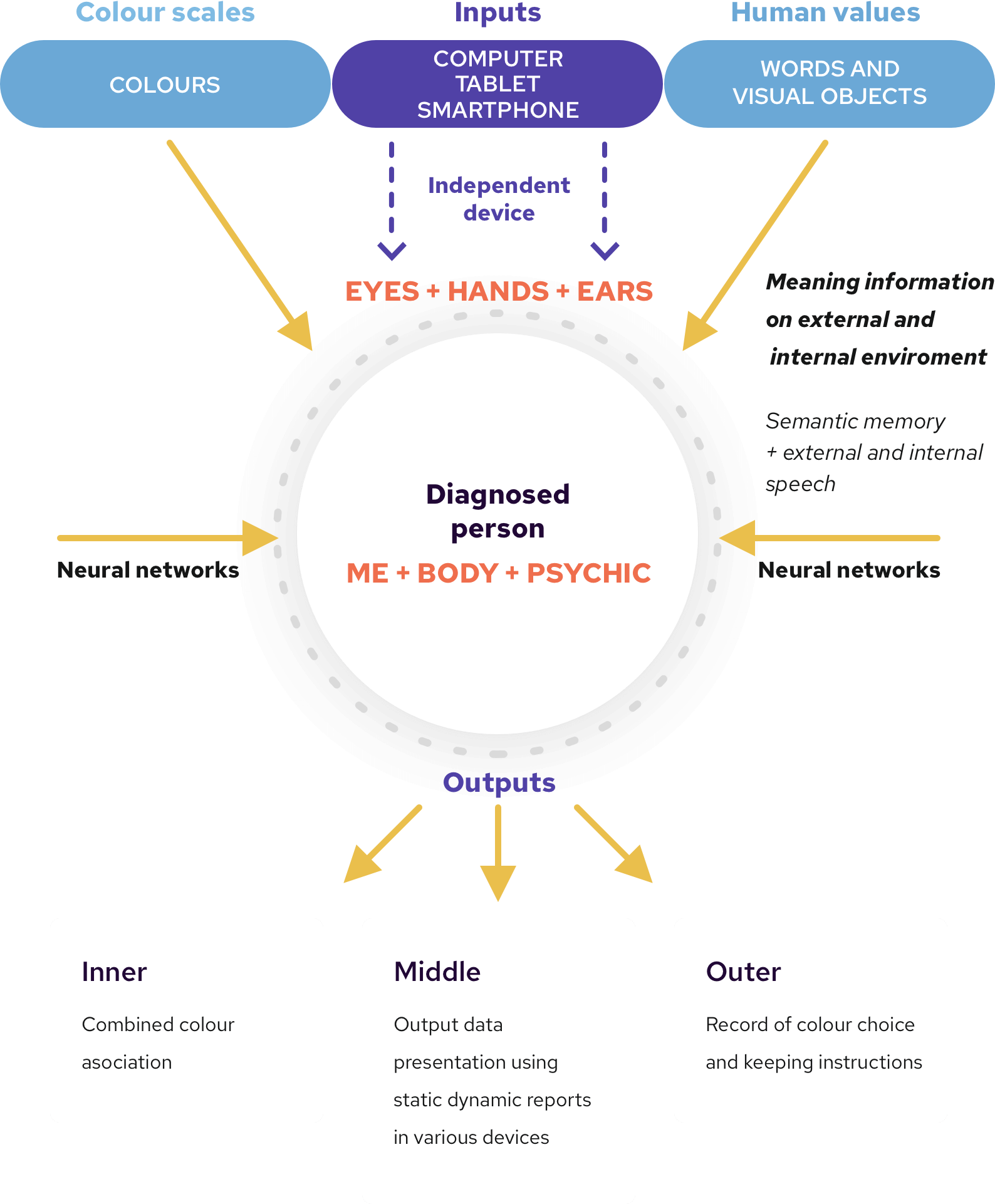
The respondent is not limited in the diagnostics either by the amount and quality of the “known” information, nor by the level of their rational thinking, because they use the association mechanisms for answers, which are almost identical for all people. It differs only in its content quality and target orientation, which, corresponds to the individuality of each person. The measured information about the so-called mental phenomena of an individual or a group is complex, comprehensive, and respects the long-term and short-term evolutionary processes of the individual's brain development.
After the diagnostics is finished, the output for the measured areas is generated automatically and online. Outputs are in the form of static and dynamic data, and visualizations. They are designed to be viewed on a computer, tablet or mobile phone.

Diagnostic Result
Diagnostic Result
The results of the diagnostics are specific outcomes in numeric form, which are represented in the output reports. Their content, scope and form correspond to a specific issue.
CA method diagnostics results are always interpreted by a competent person in accordance with the Code of Ethics.
Artificial intelligence is also involved in some products. In these products, the diagnostic results affect a change in application behaviour. The application learns, and improves itself, in accordance with user behaviour.
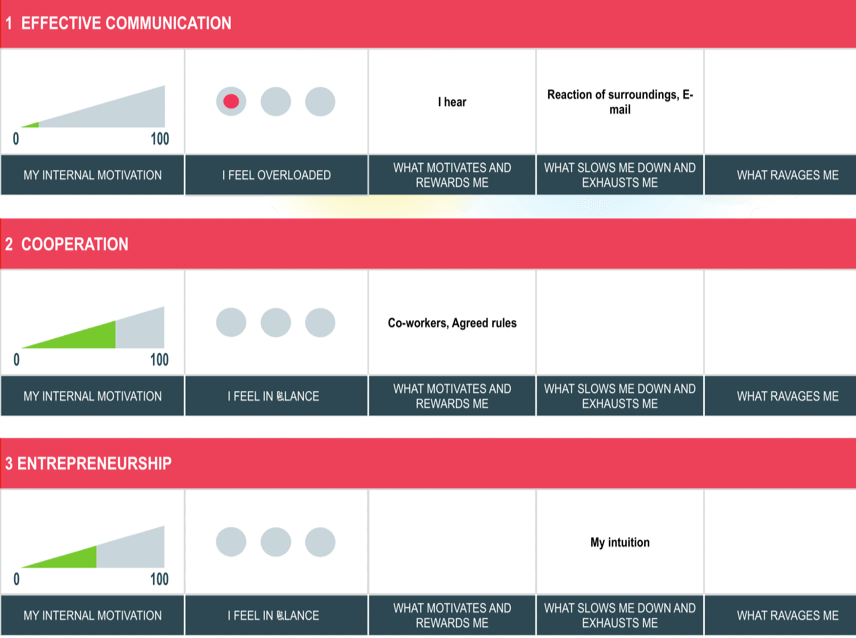
Patent Application
In 2013, a patent application for CA method was submitted. The patent application includes an exact calculation of the sample parameter from the input data to the output as the individual parameters are processed in the computing core.
The system and method of a computer-based market research analysis
Identification
US 20140067475 A1
Translators
ŠIMONEK, JIŘÍ, ŠIMONEK, JIŘÍ, BOHONĚK, ROBERT AND OTHERS
Name of the owner
DAP SERVICES A.S., CZECH REPUBLIC
Abstract
A market research computer implemented method for evaluating correlation between an entity and concepts associated with the entity. First, the method includes sending from a database, to many users data indicative of the entity and the concepts. Next, repeatedly performing for each user: collection of data indicative of sub-group of color selections, from a predefined group of colors, for both the entity and the concepts. Next, creating a data structure representing Color Association (CA) profiles respectively for each concept of the specified concepts by aggregating of sub-groups of colors selections by the users in respect of the concepts. Next, creating a data structure representing a Color Association (CA) profile for the entity by aggregating sub-groups of color selections by the users in respect of the entity. Next, calculating correlation between a CA profile of the concepts and the CA profile of the entity and reporting on the correlation results.
Detail of patentFAQ
Diagnostics Use
WHICH COLOUR IS THE CORRECT ONE?
The diagnostics process is intuitive and emotional. Like most decisions we make in the course of our lives. No colour is right, but also no colour is wrong. Likewise, there is no good, bad, or other type of colour or their selection order.
I DON'T BELIEVE IT! ARE THE RESULTS RELEVANT?
CA method went through decades of development, during which it was refined and validated. It has been recognized by expert committees at numerous world conferences. It was the primary research tool for several professional publications. The Method is used by more than 500 major organizations. The diagnostics is available in 32 languages, and hundreds of thousands of people have used CA method. The best way to verify its corresponding value is to try the diagnostics.
HOW DO I USE THE DIAGNOSTICS TOOL?
Take this approach to the diagnostics: Before engaging with CA method's diagnostic tool, relax and unwind. Make sure you are in a quiet environment where you won't be interupted by mobile phones, other people, or multitasking. Briefly interact with each word or visual stimulus. Close your eyes and think about what the word means. What you usually think of first is “important”. Think of “mum“. Your mum, wife (if you are man), or even yourself (if you are a mum), may come into your thoughts. You may even think of all three together. It does not matter. Then open your eyes, look at the colourful balls, and click on the three that you like best at the moment, or the ones that suits the term the best. Be sure not to speculate too long on whether or not you have chosen the correct colours. Only the first colour is important and cruicial in your life.
WHY DOES THE DIAGNOSTICS CONTAIN EIGHT COLOURS?
These colours were chosen because each colour emits a specific colour frequency that will not be confused with any other. The colours are arranged in a specific order so that they do not form typical pairings that most people tend to connect or choose. For example, another colour is always inserted between grey and black. Colours change their position within the diagnostic process, they rotate position. This is beause during a longer diagnosis people begin to be come stereotyped, or memorise the location and pattern the colours are placed in. In order to revive the colour associations and get real answers, colours must change their position. More here.
IS THE USE OF DIAGNOSTICS LIMITED BY AGE?
Diagnostics can be used by children from age 3. The diagnostics for children of this age is shorter and only a very limited number of characteristics are detected. There is no upper age limit for the end user.
HOW DO I HELP MY CHILD TAKE THE DIAGNOSTICS?
Different age groups are diagnosed differently. However, there are principles and rules that facilitate the diagnostic process to ensure more objective results. First, take the time to learn about the method and diagnostics. Next, try the diagnostics yourself so that you know what to expect and how to guide the child. With young children it is essential to teach them how to click using a mouse or trackpad, or select areas of a screen before they take the diagnostics test. You should also give them an idea of what to expect. Explain that there is no good or bad colour choice, and that they should not choose a colour just becuase it is their favourite. They should choose the colour that shows how they feel. This diagnostics is about feelings, and thinking too long about an answer isn't good. They should think about how they feel about a word, and what colour matches that feeling. Do not explain the individual words in detail. Let the children interpret them in their own way. For example, do not delve into the word “sex” or worry about them misunderstanding it. After all, from an early childhood they “hear and see” it everywhere. For more complicated words like “observation“, say that it means a visit from the headteacher to the classroom. If the word is ICT coodinater, explain that this is a person who takes care of computers. Make only a passing reference.
For children who cannot read, children in kindergarten or year one, it is necessary to perform the diagnostics sensitively, slowly and simply read the term to the children. First years can click on colours themselves. If they can't, click on the colours they point to with their fingers.
Diagnostic Results
I DO NOT UNDERSTAND THE DISPLAYED RESULTS.
Some of the results produced by certain CA method applications are designed to be understood by you, the respondent. Other results need to be interpreted or explained by a CA method specialist in order to avoid misinterpretation. Training and consultations are a part of the support provided by people and organizations working with CA method.
CAN FATIGUE, MOOD, OR OTHER EMOTIONAL STATES, IN A GIVEN MOMENT HAVE AN EFFECT ON THE DIAGNOSTIC RESULTS?
Yes, if the diagnostics contains fewer words. Shorter diagnostics are usually used measure the respondent's current state (energy). With a larger number of words, people respond based on their inner feelings, allowing us to measure longer-term conditions. In these cases the current emotional state of the respondent does not affect the diagnostic result. These transient and fluctuating influences will not be reflected in essential values and 'internal settings'. Click here for more information.
I HAVE REDUCED COLOUR SENSITIVITY, OR COLOUR BLINDNESS, HOW WILL THIS AFFECT MY DIAGNOSTIC RESULTS?
In layman's terms, the human brain perceives and uses colours “in its own way”. The eyes are a mediator and transmitter of the outside world to your inner world. We do have the diagnostic results of people who have visual or colour blindness, and the quality of their diagnostic results is comparable to that of a person who has typical colour vision or vision. Diagnostics would be equally good if you had, for example, a black-and-white monitor and saw only shades of gray instead of colours. Essentially, the results would be similar. Similarly to television, film, and paintings, colour allows us to respond more sensitively and deeply. The results of the diagnostics are then 'sharper and more detailed'.
IS IT POSSIBLE TO INFLUENCE THE OUTCOME OF THE DIAGNOSTICS?
Diagnostics can be manipulated, but this is automatically recognized by the system. A strength of CA method is that it is not possible to influence or stylise the results of the diagnostics. The method raises minimal client defenses. If a person wants to disrupt the system, they choose predetermined answers, e.g. they choose three colours for all answers. However, this will be caught by the system and discarded. If the respondent clicks on the colours to reflect how they actually feel about a term, then it is not possible to influence the results. There are ratios and correlations of individual colours and concepts, and the number of variables is so high that it is not possible to estimate which ratio of colours and concepts is optimal. To truly influence the results, a person would have to know the meaning of each colour, and the norms assigned to each concept, age groups, gender, and more. In short, they would have to be a CA method expert.
Technical Requirements
IS THE INFORMATION I PROVIDE SECURE? ARE MY DATA SECURE?
Yes, your data is secure. We take our data security seriously, and use up-to-date security encryption to ensure that it will not be lost or stolen. We also secure our mobile device applications with your unique username and password, to help protect your diagnostic results stored in the app.
IS IT POSSIBLE TO CARRY OUT THE DIAGNOSTICS ON A SMARTPHONE?
CA method does have some products available for use on a smartphone. As there are many different CA method applications, and they can be customised, different applications are avaiable for use on a computer, tablet, or smartphone. Please contact us for more information regarding which application is available for which device, and whether or not you would need a customised product.
Use of the Method
IN WHAT FIELDS IS THE DIAGNOSTICS TOOL CURRENTLY USED?
The scope of the diagnostics tool has been broad since its inception. It is used most often in human resources, sports, education, marketing, healthcare, or psychology.
WHERE CAN I TRY THE DIAGNOSTICS?
A number of business partners offer the opportunity to use CA method diagnostics. Contact us and we will provide you with an apporpriate contact.
I WOULD LIKE MORE INFORMATION.
If you did not find the answer you were looking for, feel free to contact us. You can find our contact details on our Contacts page.
